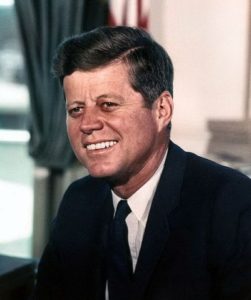Make One Point
One Point Preaching

John F. Kennedy was one of the great speakers in the history of the United States. People still study his speaking style and delivery, as well as the content of the speeches he made. One of the great secrets of his speeches came as the result of advice that he received from a friend. When he entered politics, according to the story, he was having a difficult time keeping audiences with him. A trusted friend said to him, “The problem is that you speak in paragraphs. The people in the Unites States think in words and sentences.” He began to make one point in his speeches from that point on, a memorable phrase that people could catch and hold.
I don’t know if that is a true or apocryphal story, but Kennedy learned that lesson well. One important key that will make your sermons more impactful is this: make one point in your messages.
In the last two postswe began the discussion about where you are going with your message. Wherever it is, you should be able to describe it in a meaningful phrase.
Examples of make one point
Let me give you some examples of the main point of Kennedy’s speeches. “Ask not what your country can do for you; ask what you can do for your country.” “‘Ich ben ein Berliner.” Or his challenge to put a man on the moon by the end of the century. Each speech had one major point, and that is what people remembered.
Your sermons and one point
What about you? What do people remember of your messages? You will be more effective in your preaching if you practice the discipline of making one major point in your message. In other words, you create a one-sentence summary of what you want your people to remember. Then you build your message around that one point.
Andy Stanley’s example
Andy Stanley, an excellent preacher in the Atlanta, Georgia, talks in his book, Communicating for Change about how he came to this secret. He had been asked to do a chapel at a Christian High School, and decided to use the story of Naaman and Elisha in Scripture (2 Kings 5 ). He studied the passage thoroughly, and then made an outline. His outline looked like this: Naaman’s Problem, Naaman’s Pride, Naaman’s Plea, Naaman’s Proof. The night before he was to deliver the message, he was praying for the students. He began to think differently about his message.
“As I was praying, it occurred to me that they weren’t going to remember one thing I said five minutes after I said it…. I got up off my knees, sat back down at my desk, and determined not to let that happen. I got rid of my alliterated points and boiled it down to one idea. Then I worked on it until I had crafted a statement upon which I could hang the entire message.” (Andy Stanley, Communicating for Change page 11).
In the message he told the story, and concluded with the idea that God sometimes asks us to do things that we don’t understand. Then he delivered his one sentence: “To understand why, submit and apply.”
Two years later, he had a young man come up to him and say that he remembered that message, and was able to accurately say the summary phrase.
Wouldn’t you love to have that kind of thing happen with your messages?
Here’s another view of this idea and how to apply it to your messages.




Leave a Reply
Want to join the discussion?Feel free to contribute!